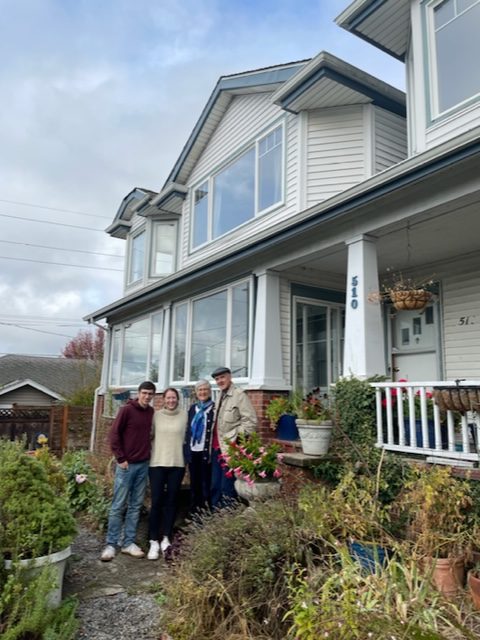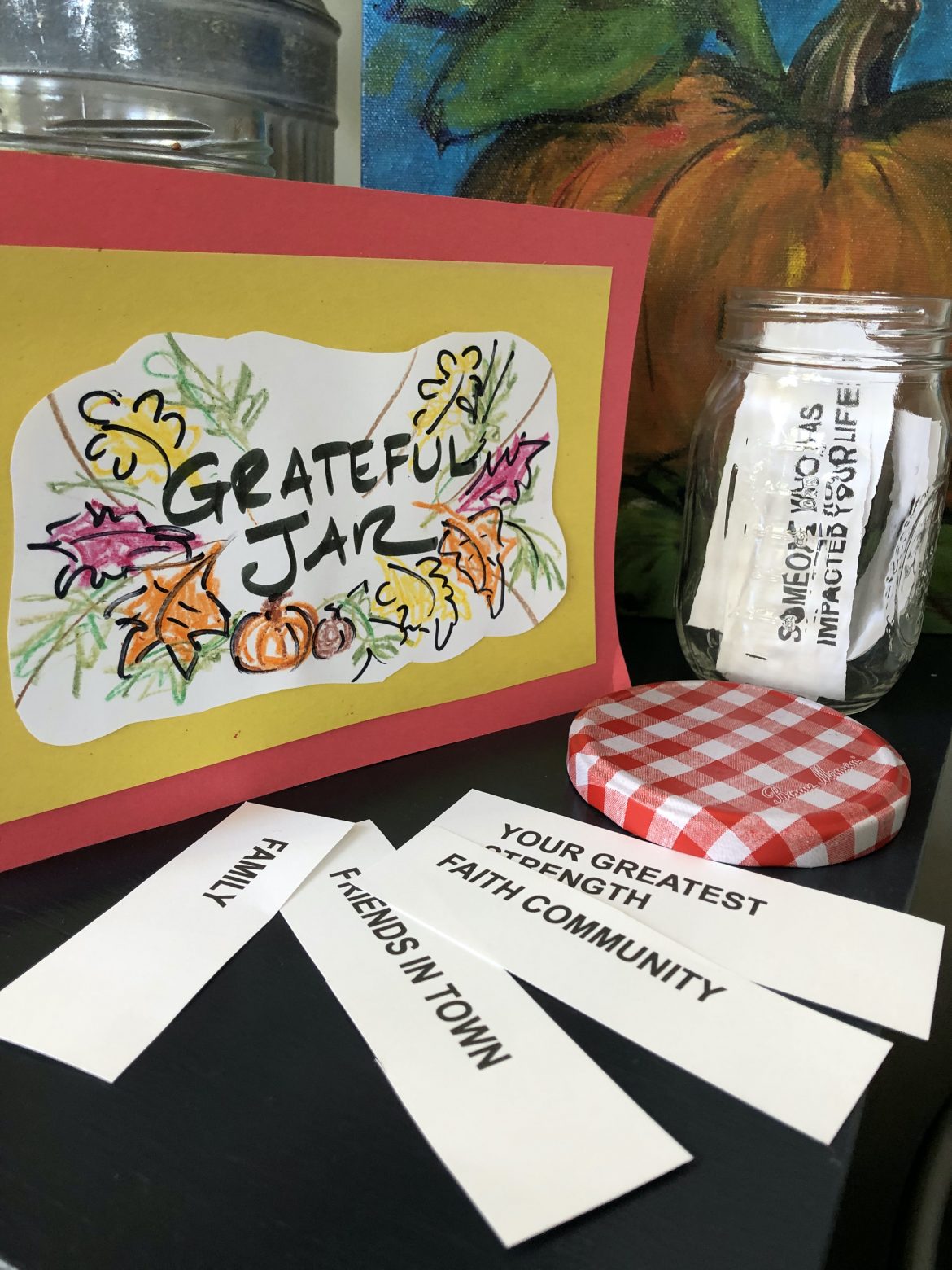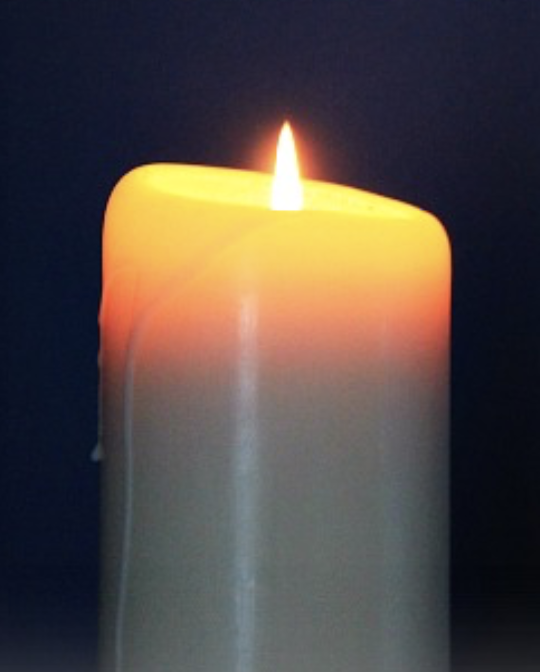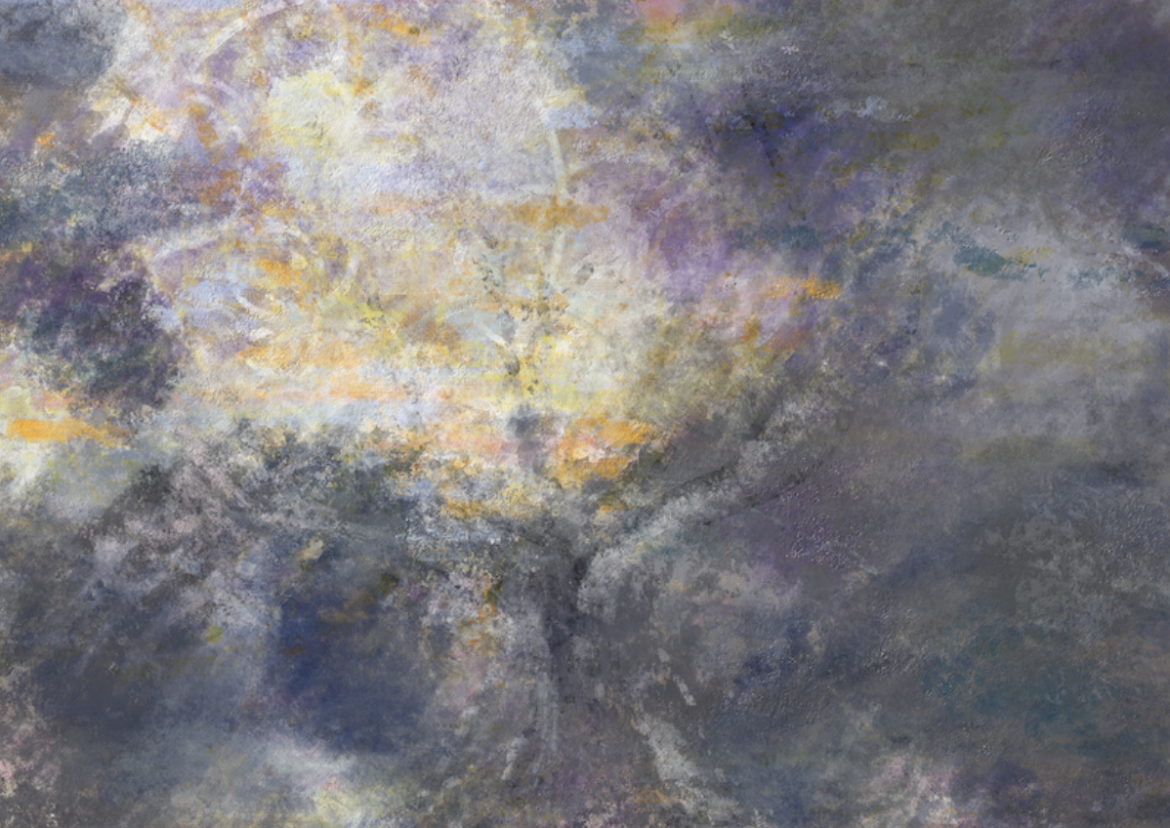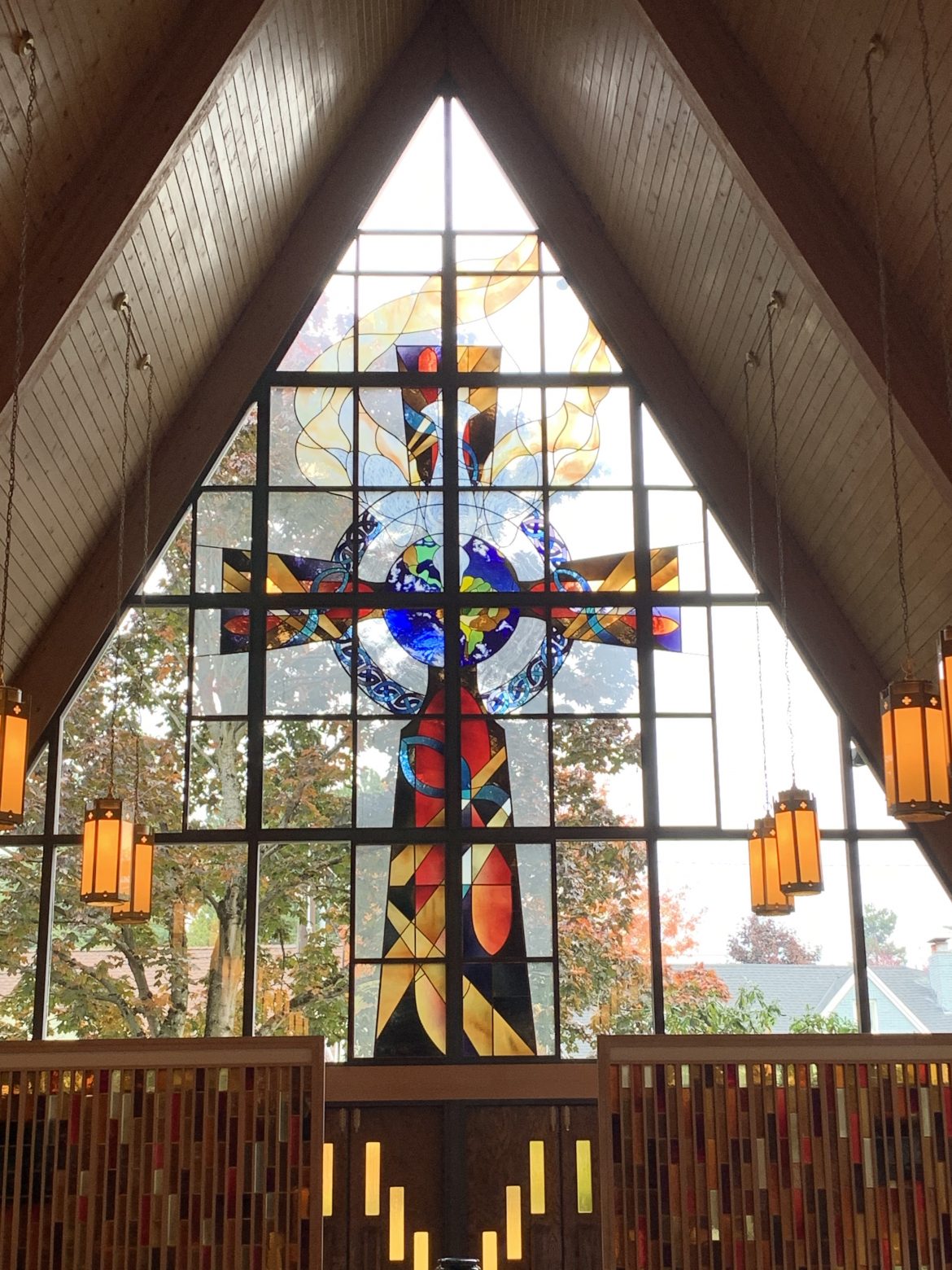By Tom Sine
Christine and I recently celebrated our 30th anniversary. We reflected back on the early days of our marriage here in Seattle. We also celebrated our wonderful three decades of life, marriage and learning how to share God’s generous hospitality with good friends in Britain, Australia, New Zealand and the United States and Canada. However since the pandemic began our traveling has cut back and we do miss the hospitality of our friends in Britain and down under.
I suspect many of our friends don’t know that when Christine and I began our journey together over three decades ago we decided to make hospitality as a major part of our shared life. When we settled in Seattle we bought an ancient house that was built in 1910 before the First World War and the first global pandemic. It was surprisingly inexpensive back then. It consists of three two bedroom apartments stacked on top each other. Christine did a great job of directing a little remodeling on all three floors.
Christine lived in community on Mercy Ships, before we were married, where she headed up the medical ministry. I lived in community with a small household for Christian men. Not surprisingly we purchased this three apartment house to create a modest Christian community we call Mustard Seed House.
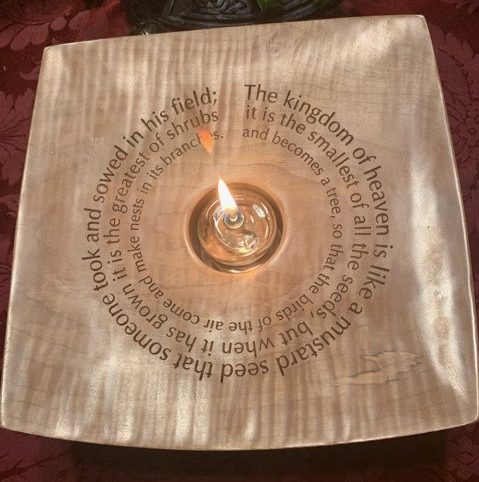
Mustard Seed House Oil Lamp
For 30 years we have been inviting younger couples to live in the other two units. We always offered them reduced rent which is becoming increasingly important for Gen Y and Z as rent prices are soaring in Seattle. Christine and I have so enjoyed life with our new friends as we all tried to help one another life our best lives as people of faith. So many good memories.
To join us in Mustard Seed House Community we ask them to share a meal with us once a week where we share about our faith and issues in our lives and faith, and we garden together once a month and share the produce from the garden. Last year we harvested and shared 100 pounds of tomatoes and 400 pounds of apples. Before the pandemic we enjoyed offering hospitality to large groups of other friends.
After we stepped down from Mustard Seed Associates which we ran out of our garage, we deeded over our 40 acres on Camano Island to Circlewood headed by James Amadon as a Christian Environmental Study Center.
Then Christine started her new blog site godspacelight.com in 2008. I have been surprised and delighted how people all over the planet so enthusiastically not only started tuning into this site on spirituality, prayer and community but also posting on her site. I don’t know of any other Christian sites on prayer and spirituality that engage over one to two thousand Christians a day from all over the planet.
I plan to start posting on Christine’s site virtually every week. Much of my posts will be about Gen Y & Z that I call “the Good News Generation.” Many of the young in our churches that are a part of the Good News Generation, are not only keen in their spiritual practices but they also care much more about issues of environmental, racial and social Justice.
For example, Rebecca Conner, who is Christine’s newest assistant, is a member of the the Good News Generation and is also an active member of the Covenant Church. Like many in her generation she is particularly concerned about the daunting changes facing the environment. She earned a BS in Environmental Science and a BA in Philosophy at North Park University in Chicago. Rebecca has just returned from Fairbanks Alaska where she worked a leader in a Flora Field Crew in an environmental project before coming back to Seattle to work with Christine.
I also am a big fan of Gen Next. In fact in my most recent book 2020s Foresight: Three Vital Practices for Thriving in a Decade of Accelerating Change that I wrote with my co-author Dwight Friesen, I describe a number of the good news generation who live in co-housing to reduce their living costs so they have more discretionary time to work in neighborhood empowerment projects to extend hospitality to people who have been displaced increasing waves of severe weather.
I recently did a Futures Creativity Workshop with a Presbyterian Church outside of Seattle. These church leaders knew their congregation was graying like many mainline churches. However, they hadn’t noticed they no longer had any young families. During they work shop one of the five creative groups came with a creative new way to offer hospitality to young families. This group remembered that they had a large building that was under utilized.
They came up with the creative idea of offering an art class to elementary school students after school to reduce child care costs to young families…which is likely to be very popular and provide a community service.
If you and your congregation are interested in my leading a Creativity Workshop in your church or share how you create innovative ways to both be a difference or make a difference in these turbulent times you can contact me at twsine@gmail.com or 206-524-2111.
This is your invitation to join the good news generation in creating new ways to both be a difference and make a difference expanding God’s hospitality in times like these.
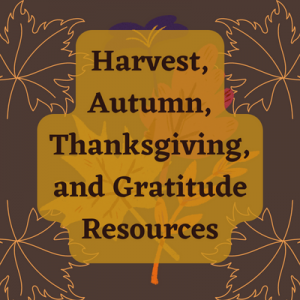 Did you know? Godspace has many resources available for the season of Autumn and the season of Thanksgiving! From harvest helps and reflections, holiday guides, an online retreat, litanies/liturgies, prayers, and more – check it out on our Seasons & Blessings page!
Did you know? Godspace has many resources available for the season of Autumn and the season of Thanksgiving! From harvest helps and reflections, holiday guides, an online retreat, litanies/liturgies, prayers, and more – check it out on our Seasons & Blessings page!
I am a huge fan of Fall! This week we have cooler temperatures in Nashville and it actually looks and feels like Fall for the first time! I had a great time driving out of town a bit and seeing all the trees with their colorful leaves. I am so grateful! It reminds me that Halloween and Thanksgiving are not too far away! I know that our Canadian friends have already celebrated Thanksgiving but we can all use some practical ways to practice gratitude and thankfulness, especially with everything going on in our world. I know I do! And as November begins next week, we all get a fresh start, a chance to begin again and draw closer to Jesus. Here are a few ways I am connecting with God and practicing gratitude and gratefulness this season.
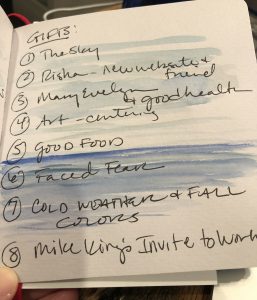
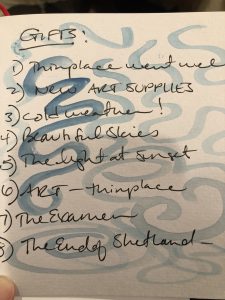
WRITING DOWN and REMEMBERING THE GIFTS: One of my daily practices is to write down the GIFTS of the DAY each morning. I take time to remember the gifts of the day before. I have a small journal where I make a list of the things I am grateful for…from the cold weather to a new job possibility, to a new friend or a good cup of coffee. No gift is too small to write down. I find that taking the time to pause and look back over the day before helps me start the new day with a much brighter point of view. This is like a mini PRAYER OF EXAMEN.
PRAYING THE PRAYER OF EXAMEN: Another practice is the praying the longer version of the PRAYER OF EXAMEN. TRY the extended PRAYER OF EXAMEN on your own. This one is based on the one led by FATHER MICHAEL SPAROUGH whom I met on a retreat the year before covid.
1. Place yourself in the Presence of God. Open your entire self to to God’s Love.
2. Review your day in Thanksgiving. “Savoring the goodness not just counting my blessings”. What made my heart smile today?
Picture Jesus smiling at you!
“Behold God Beholding You!”
3. Reviewing the Emotions and the Feelings of the day. What did you notice as you woke up? Were you grumpy? Grateful? Already stressed out? What surprised you? What delighted you? Did you lose your temper? Did you have conflict? Did you feel lonely or afraid?
Give these feelings to Jesus!
4. Prayer of Review…LISTEN
Jesus receives the negative of the day without judging you! Jesus receives your emotions, fears, sorrows, despair.
BEHOLD HIM BEHOLDING YOU
5. Turning Towards Tomorrow! Looking forward in HOPE. What has the Spirit taught you?
As you look towards tomorrow what good things from today do you want to take into the new day? Ask Jesus for the GRACE you need for tomorrow.
What do you need Jesus to provide for you so you can “BE CHRIST’S MIRROR to the World” ?
Based on Father Michael Sparough’s Examen: LISTEN HERE
Last year at our Season of Gratitude Retreat, which you can still watch and participate in, we created a Grateful Jar. I created a Gratitude Jar Kit that you can download for free at Freerangeworship.com.
You can do this on your own or with your small group, family or your entire church community. Each person or family will need a jar which can be decorated, or you can use a gift box instead of a jar. Each person/family will need a set of the words/phrases printed out and scissors to cut out the words. The idea is to create a Grateful Jar with words and phrases to help you pray and practice gratitude each day. You put the phrases in the jar and each day you randomly pick one out. I close my eyes and let the Holy Spirit choose for me. Read the selection and consider how you are grateful for this and thank Jesus for this. You are free to print out or send out the PDF to your community, just let them know you got it from freerangeworship.com and Lilly Lewin!
You can also use the drawing of the Grateful Jar as a prayer response during worship with your church community or in your small group. Each person will need a picture/handout of the jar and a pen or pencil. Invite participants to consider all the gifts of this week, all the things you have to be grateful for in your life today…
WRITE these things on your jar. Ask Jesus to show you.
Give people time to actually write down these things. After they have finished writing, have participants hold the paper and pray together. If you use slides, you could do this as a corporate prayer, praying this aloud together. If you are using this with a small group or youth group, you could have people share in pairs what things they are thankful for. The prayer can be something like this:
“Lord we thank you that you fill our lives with Good Things.
Even when things are dark and confusing, you give us things to be grateful for each day.
Thank you for all of these things!
Help us to notice and pay attention today and everyday to the good gifts you give us!
Thank you Lord. And all God’s people said “AMEN”
We’d love to hear how you use the Grateful Jar, so send us your stories and pics! And since it’s Halloween on Monday, save a few piece of candy and you can pray with it as a family, individual or a group! Check out Praying with Chocolate and get the free handout here.
Grateful for all you do each day to love and serve others! Thank you!
©lillylewin and freerangeworship.com
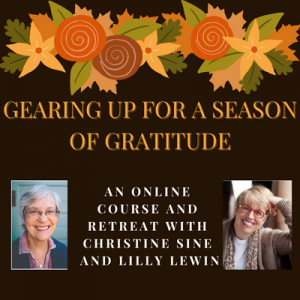 Christine Sine and Lilly Lewin inspire ways to get geared up for the coming season of gratitude in this popular online course! Sign up for 180 days to enjoy this retreat at your own pace – including craft tutorials and print-outs plus much more. Check it out in our shop!
Christine Sine and Lilly Lewin inspire ways to get geared up for the coming season of gratitude in this popular online course! Sign up for 180 days to enjoy this retreat at your own pace – including craft tutorials and print-outs plus much more. Check it out in our shop!
Winter is upon us. According to the ancient Celtic calendar, winter begins November 1. It makes sense to me to mark the beginning of winter in November rather than December 21 as the Julian calendar suggests. This Celtic season of winter, called Samhain, means “summer’s end.” In the seventh century Samhain was Christianized as All Saints’ Day, also known as Hallowmas or Hollantide, or later in history as All Hollow’s Eve which has morphed into the present Halloween holiday.
As a Christian who embraces Celtic spirituality, I find it helpful to celebrate the four seasonal festivals on the Celtic Calendar AND the holy days on the Christian calendar. I celebrate the Feast of All Saint’s on the first Sunday following All Saints’ Day (November 1) at my local Episcopal Church. It is important to me to give thanks for all the lives of saints as well as dear family members and friends who are now in the nearer presence of God. Christian communal celebrations strengthen my faith. Yet, I find that observing the four Celtic festivals of the year also enrich my spiritual journey.
Samhain is believed to have marked the beginning of the Celtic New Year. Thus, it is an appropriate time to acknowledge endings in our lives as well as new beginnings. We can align ourselves with the season of harvest not only in an external way but also in a spiritual way. It is a time to separate and allow to die that which is no longer useful or relevant in our lives. What old habits and attitudes need to be released? Ritually observing Samhain gives us the opportunity to practice letting go of the old, and embracing new seeds of hope and love yet to be incubated and born at Christmastide. Mara Freeman, in Kindling the Celtic Spirit, writes,
In the country year, Samhain marked the time when the final harvest was gathered. Animals destined for the table were slaughtered and their bones were burned in the November bonfires (i.e., originally bone-fires). The bonfire also provided an island of light within the oncoming tide of winter darkness, keeping away cold, discomforts and evil spirits long before electricity illumined our nights.
Before I retired from full time parish ministry, I offered Celtic services that marked the four festival days, the solstices and the equinoxes. The first year that I offered a service for Samhain I wanted to include a bonfire as part of the service. Alas, snow and bitter cold outdoors made it impossible. As I thought about the “bone-fires,” it struck me that the original point of the fires was to burn the dregs of what was no longer useful. Poking around cabinets in the church, I found dozens of candles that had enough wax left to burn and yet had been sitting there for ages. No doubt they had not been used because they were no longer looked attractive enough for ritual use. Not surprising, there were plenty of advent wreath candles! Here was my opportunity.
Several of us gathered up the candles and some brought the dregs of their candles from home. We placed them all in a circle on the floor in the hall and gathered around them. It was an eclectic and beautiful fire to behold. It was snowing outside but the warmth and beauty of the bonfire lightened our hearts as we celebrated the beginning of the season of frost and fire.
I still do this ritual at home. Sometimes I have done the ritual on Halloween night, which has restored a sense of spirituality that once was part of All Hollow’s Eve. In earlier centuries of the church, ministers and lay people alike donned white vestments (symbols of resurrection life) and carried lighted lanterns through the church’s cemetery to bless the graves of beloved members “departed from this life in faith and fear” (Book of Common Prayer).
Praying around my home bonfire connects me to Samhain, the tradition of the church, and the joy of welcoming trick-or-treaters. It also helps me clear out space for the new candles of Advent and Christmas!
To me it feels as if we are entering this year’s dark season in the midst of the darkest times. It is easy for me to feel overwhelmed by the many wars, violence, climate disasters, national saber rattling, political polarization, economic stress–the list could go on. Gathering around my fire helps me to face my own Shadow, blind spots, fear and negativity. Facing my own inner darkness helps me not to project it onto others. It also enables me to face the world’s darkness with hope and a renewed desire to see the light and beauty in the most disparate situations of despair. Rather than turning away from the darkness, I want to be resilient enough to pray for the suffering and those who cause it.
This year I will celebrate Samhain on November 1 with a few friends. They will bring the dregs of their candles and we will build our bonfire together. We will offer prayers, sit in silence, participate in a ritual of letting go, and meditate on this passage from John’s Gospel:
Jesus answered them, ‘The hour has come for the Son of Man to be glorified. Very truly, I tell you, unless a grain of wheat falls into the earth and dies, it remains just a single grain; but if it dies, it bears much fruit. Those who love their life lose it, and those who hate their life in this world will keep it for eternal life. Whoever serves me must follow me, and where I am, there will my servant be also.’ [John 12:23-26]
I invite you to observe and create your own festival for Samhain. It can be done anytime between the “thin spaces” of October 30 and November 2. You can create your own bonfire of candle dregs, read the passage from John’s Gospel and include a ritual of letting go. Here is a copy of Mara Freeman’s ritual for Samhain:
A Ritual of Letting Go
For this ritual, you will need a piece of yarn, string or cord with enough length so that that three knots can be tied.
Reflect on the following questions. Think about one thing that you would like to release in response to each question.
- What old habits, patterns, and way of being no longer serve you and your relationships?
- What things from the past adversely affect your family or your community’s well-being and would best be forgiven and forgotten?
- What does our planet need less of to make it healthier?
Be clear about the three items for each question that you genuinely wish to release. Now take the piece of yarn, string or cord and make three knots in it, one for each issue. As you make each knot, visualize each situation clearly, and imagine every aspect of it being firmly bound into the knot. Bury the knotted cord where sun, wind, and rain cannot touch it, and let it rot away (Mara Freeman, Kindling a Celtic Spirit, p. 305).
However you choose to cross the threshold between October and November, may you remember the old Irish saying, “It’s better to light a candle than curse the darkness.” May it be so for all of us. Amen.
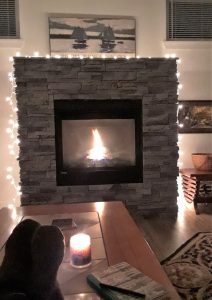
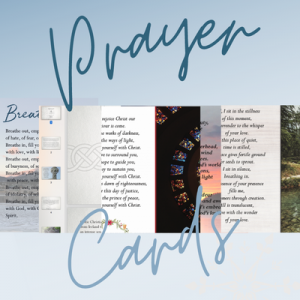 Prayer cards are available in the shop for many occasions and seasons–from everyday pauses and Lenten ruminations to breath meditations and Advent reflections, enjoy guided prayers and beautiful illustrations designed to delight and draw close. Many are available in single sets, sets of three, and to download–even bundled with other resources!
Prayer cards are available in the shop for many occasions and seasons–from everyday pauses and Lenten ruminations to breath meditations and Advent reflections, enjoy guided prayers and beautiful illustrations designed to delight and draw close. Many are available in single sets, sets of three, and to download–even bundled with other resources!
Back at Easter, I was wondering what on earth I had to contribute to the Godspace blog’s next theme: ‘Living as Christ lived: towards justice, love and peace for all creation’. What do I contribute towards? Do I even remember I am supposed to be living as Christ lived – in any concrete, detailed, particular sense – to the betterment of our world, to the building of the Kingdom of God?
As a writer, poet, blogger, contemplative photographer and visual artist who lives with chronic illness, who is often house and/or bed-bound, of course I hope I increase the amount of love in the world; of course I hope I pray for, and act for, peace. Yet what do I contribute towards justice: towards making my immediate neighbourhood, or the various local/national/global communities I tangentially touch, less unjust? Do I even understand what ‘justice’ might be needed by the people I live amongst?
Part of the work of justice, it seems to me, is making openings for those who are marginalised – unseen or unrecognised by dominant cultural narratives – to tell their own story in any way they choose. Not just so that the voice of an individual, a group, or a nation can be physically heard; but so that within the act of telling healing might begin. Healing which will lead to grief, pain, anger, poverty and all the other consequences and emotional reactions to trauma of any kind, anywhere, being transfigured so that lives can be lived and released each according to their calling.
This makes telling an integral part of Justice, making it about recognition and release, celebration and gratitude. Each telling is unique: God’s created world and peoples are infinitely, wondrously varied. If the stories of trees and stones are revelatory gospels where Spirit can be read, how much more so might the Spirit pour out in loud acclamation from the stories of precious people who currently do not know how to make their voice, their story, their gospel, be heard?
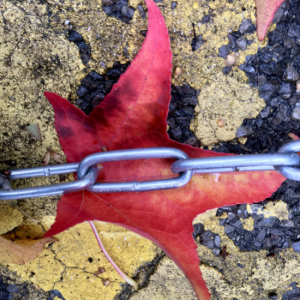
“the only way to seek justice is through the power of stories”
Leslie Marmon Silko
… It is now Autumn. That piece for the summer theme was never finished due to brain-fog. I could think of nothing I had to say. The current theme on the Godspace blog is ‘Gratitude as Guests of the world’, so I am trying to work out how to finish what I wanted to say! The link is about stories.
This year, extremely tentatively, I have begun sharing my own story using the medium of my ‘digital one-finger paintings’. As I explained in Godspace’s Artful Julybilee a few months ago, these paintings are made whilst I am experiencing seizures which (at the moment) are a daily occurrence of the Functional Neurological Disorder (FND) with which I live. In so many ways these seizures are unwelcome ‘guests’.
Those are the bare bones of the story I have to tell. And I’m beginning to get the message that I do have to tell it! Anyone might be helped, for whatever reason, if they are given the means to express themselves. In this case the means are an iPad or similar and a £10 to buy the app. It sounds simple – and it should be – but for tech poverty and financial poverty: both of these might be holding back someone from telling us a story, releasing a testimony which might change the world.
My art is not political in any conventional sense of the word, though I suspect that everything we do has seen or unseen political ramifications somewhere. In this case, my art is political by the very means by which it is produced. Not only am I privileged enough to have been able to afford the tech (secondhand), although I may often feel socially isolated, I am fortunate enough to have a thoughtful friend who had given me an app store voucher for Christmas (which exactly covered the cost of the ArtSet 4 app I use). Yet, for all that this technology has freed me to tell my story, at what price does that telling come? What about the impact this tech has on the planet? Suddenly my art is part of a discussion about rare-earth minerals and who mines them, controls access to them, and what happens when they run out. These are all political hot-potatoes. They are justice issues too – for people and for the planet. Who decides if the resources necessary to release a person’s story so that healing may begin, so that Kingdom may be built, are ‘worth’ the cost? I wonder, are there different ways I can tell my story which are more responsible and more responsive to the needs of other peoples and our planet?
Suddenly my little digital finger paintings are looking highly political! All too often, the Gospels tell that when Jesus encounters individuals the personal is political. Jesus rapidly makes it apparent that to flourish as a beloved child of God we should challenge every single received opinion and lifestyle choice we have ever made or will ever make.
And so, before I jump ahead to the complex question of resources, I find myself asking this question: Is offering encouragement to others, urging them to tell their story, an act of justice? Is that small invitation, “tell me about it, show me how it is for you”, only applicable in the end for those with the means (financial, social, educational, emotional, physical, technical etc) to provide themselves with a way to connect to that ultimate citizen-broadcast medium: the world-wide-web? Surely not.
(‘encouragement as justice ii’ will follow…)
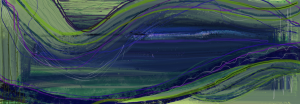
 Christine Sine and Lilly Lewin inspire ways to get geared up for the coming season of gratitude in this popular online course! Sign up for 180 days to enjoy this retreat at your own pace – including craft tutorials and print-outs plus much more. Check it out in our shop!
Christine Sine and Lilly Lewin inspire ways to get geared up for the coming season of gratitude in this popular online course! Sign up for 180 days to enjoy this retreat at your own pace – including craft tutorials and print-outs plus much more. Check it out in our shop!
Halloween is still a week away, but by the Halloween costumes, candy and gruesome house decorations appearing, and the horror movies ready to launch, I would say it is very much on peoples’ minds here in the U.S. So it is time to think about what you are going to do. Now I am not an advocate for Halloween. When I grew up in Australia it was not really celebrated and it always seems weird to me that Christians celebrate it as much as non Christians but here in America it is such a part of the culture that we really need to think about creative faith-based ways to celebrate. And I must confess that carving Halloween lanterns can be fun.

jack o lanterns
I am not going to get into the theology here. Some Christians see this celebration as evil and like to stay home with lights off. Others feel we should participate in ways that engage and redeem the culture. I am of that persuasion and so thought that you might like some resources to help you too:
Verge Network has a useful article Twelve Simple Ways to Be Missional this Halloween
Another helpful article from Grace to You: Christians and Halloween. It includes some historical perspectives as well as some suggestions for alternative celebrations like harvest or Reformation festivals. They also point out that there are some not so good alternatives like Hellhouse evangelism. I particularly love the idea of taking acts of mercy out into the community and treating treating” needy families with food baskets, gift cards, and the gospel message.
One alternative is to hold an All Saints Party. Rather than celebrating Halloween celebrate All Saints Day November 1st. Have kids dress up as their favourite person or saint. Finding Truth in Halloween is a good article to start with. It has some great ideas for All Saints/Halloween party with downloadable coloring pages for kids.
This is a great alternative way to share stories (maybe of the saints that have most influenced you life), decorate pumpkins if you must but also consider some alternatives like decorating window panes with non-toxic paint markers, making Christmas decorations and wreaths. This article from Christianity Today is a thoughtful approach. You may also like to look at: Should Christians Celebrate Halloween and Should Christians Celebrate Halloween (yes 2 different articles with the same name) which are good articles about this.
One of my favourite ideas is Reverse Trick or Treating: The goal is to publicize the fact that most chocolate sold in the US is tainted by child slavery and exploitative conditions for adult workers. Fairtrade eliminates child labour and ensures healthy working conditions with a living wage for workers.
Thousands of groups of Trick-or-Treaters in the United States and Canada will unite to help:
- END poverty among cocoa farmers
- END forced/abusive child labor in the cocoa industry
- PROTECT the environment
- PROMOTE Fair Trade
How? By distributing Fair Trade chocolate to adults, attached to a card explaining these problems in the cocoa industry and how Fair Trade presents a solution. You can learn more about this initiative here.
My growing concern for just working conditions for children makes me a strong advocate for this. I think it is a wonderful way to raise awareness of these issues and show consistency for our values.
I love this little video that some reverse trick or treaters put together a couple of years ago – not sure if they were part of the Fair Trade movement though.
Green America also posted an interesting article a couple of years ago that is worth a read. It highlights some of the concerns about the toxicity of paint and the waste of materials. Here are some of their thoughts and suggestions:
- Sustainable Halloween Practices: “In 2019, the National Retail Federation expected the 172 million people who celebrate Halloween to spend a whopping $86.79 per person, mostly on costumes and candy. That money adds up to a staggering $8.8 billion across the nation.” On this note, Dana Shugrue has put together a wonderful list of suggestions for 7 Easy Ways To Reduce Halloween Waste
- Face paint: A 2009 study by the Campaign for Safe Cosmetics found that 10 out of 10 children’s face paints tested contained at least trace levels of lead. This article provides some DIY alternatives.
- The Candy Problem: 41 million kids in the U.S. go trick or treating. No wonder one out of three children in America are overweight and many will develop diabetes. Consider making your own healthy treats, giving out non food items like polished stones, temporary tattoos, or friendship bracelets.
- Swap costumes: Millions of costumes are purchased in the U.S. each year. Consider holding a pre-Halloween party to swap, mend, make, or borrow costumes from your friends.
- Organize a Community or Neighbourhood Event. Green Halloween started in Seattle but grew into a national phenomenon with community events at more than 50 locations. You might want to join in the fun and get to know some of your neighbours.
What to do with the pumpkins though? Make the most of them. Kids and adults alike love carving and decorating pumpkins, but I hate to watch them slowly rotting on the porch. I grew up with pumpkin as the main part of my diet. It is great in soups, pies and roasted as a vegetable. Or as pumpkin bread or muffins. You can also save the seeds and toast them in the oven with a little salt. Here are links to some of my favourite recipes:
- Pumpkin Soup Carribbean Style with Black Beans
- Walk Through the Garden Soup
- Pumpkin Bread. This is a great recipe – and as it says it is adaptable.
- Gluten-Free, Grain Free Chocolate Chip Muffins I have not tried this recipe but it looks interesting – uses almond butter and honey instead of sugar.
- Gluten-Free Pumpkin Oatmeal Anytime Squares. Again I have not tried these but they look very interesting.
Repost: original post can be found here.
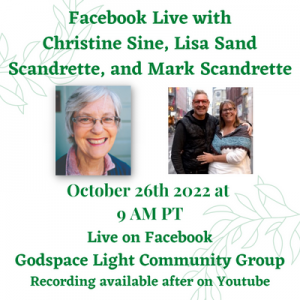
Facebook Live Tomorrow!
Join Christine Sine, Lisa Sand Scandrette, and Mark Scandrette for a discussion on pilgrimage. Wednesday, October 26th at 9 am PT. Happening live in the Godspace Light Community Group on Facebook – but if you can’t catch the live discussion, you can catch up later on YouTube!
On Friday, I walked around the garden in the rain and then went out for lunch, again walking in the rain and splashing in every puddle I found. So what you might think, you live in Seattle; it always rains there, doesn’t it? Actually no. In fact, this was one of the driest summers on record and last week the smoke billowed in from surrounding fires. It was so bad that we ranked #1 for a major city with poor air quality 2 days in a row so the refreshing rain was wonderfully invigorating and it was a delight to get out and walk in it.
I have always loved walking in the rain, though I must confess that the cold winter rain of Seattle is sometimes a little miserable for me. In fact, give me a couple of months and I will probably not be rejoicing in the rain but rather grumbling whenever I need to go out. However, if I maintain that childhood delight of splashing through puddles and relishing the raindrops falling on my tongue, it is wonderful no matter the season. And the seasons are changing so I definitely need to get ready for those cold drippy days that lie ahead.
It’s all about attitude though. I am gearing up for a new season and part of that preparation is changing my attitude to walking in the rain. This walking in the rain is really a very spiritual thing after all and there is great benefit in embracing and enjoying it whatever season I am in.
Evidently, rain is good for us not just physically but emotionally and I suspect spiritually too.
Walking in the rain lifts our spirits. Have you noticed that standing inside watching the rain pour down makes us feel grumpy and depressed whereas getting out and walking in the rain actually lifts our spirits? Raindrops on our faces and wind in our hair make us feel alive and renewed. There is nothing more invigorating than the smell of rain after a long period of dry weather, and evidently, there is a reason for that.
Bacteria, plants and even lightning can all play a role in the pleasant smell we experience after a thunderstorm; that of clean air and wet earth. Known as petrichor, the scent has long been chased by scientists and even perfumers for its enduring appeal (Petrichor: Why Does Rain Smell So Good?).
God designed us to appreciate rain and to be enlivened by it. Maybe we can even develop our own brand of fragrances from it. At the least, we can learn a few lessons as we gear up for this new season.
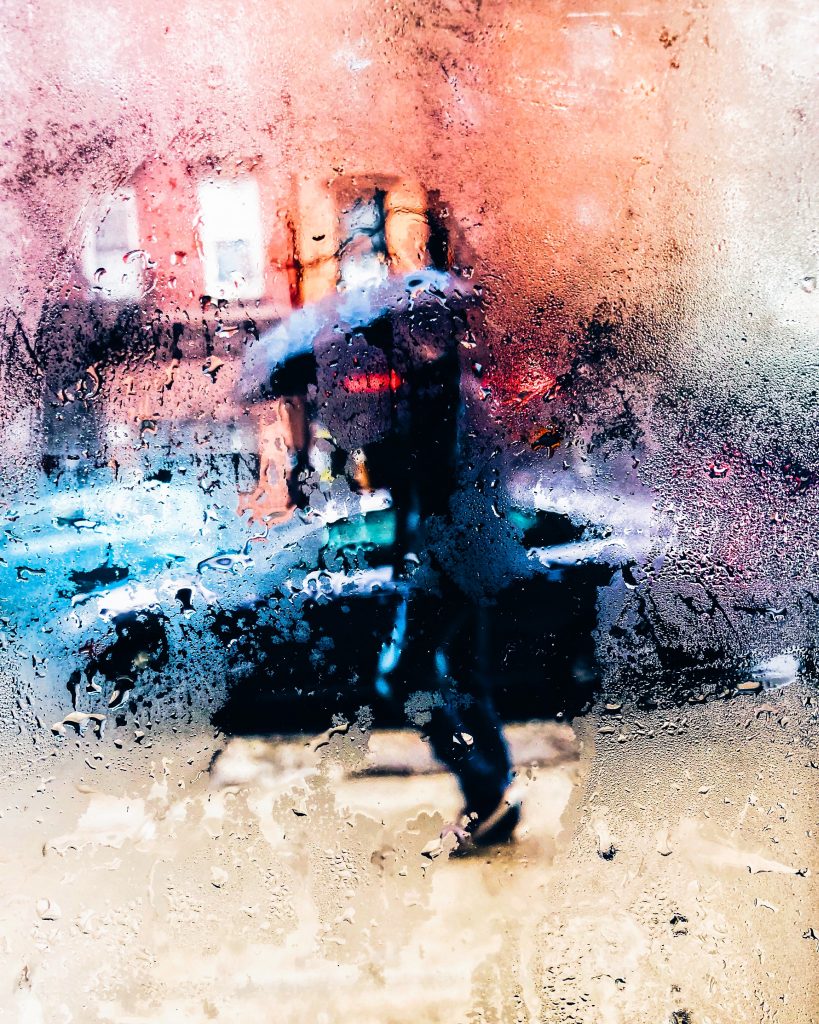
Photo by Matteo Catanese on Unsplash
Rain is a miracle that helps us see the world and the people in it differently. It changes our view of reality as though we are looking through a different lens. Familiar places look different. Well-known people look different and in the midst, we sometimes catch different glimpses of God – a God who provides the miracle of rain to refresh the earth so that the crops grow, and people thrive.
He does wonderful things that confound,
infinite numbers of miracles.
He gives rain to the earth,
sends down water to the fields;
He lifts up the downtrodden, bolsters the bereaved,
raising them to safety (Job 5:9-11 The Voice).
Rain teaches us acceptance. Rain is indifferent to our plans and our desires. I remember once praying fervently that God would stop the rain… because I had planned a picnic for that day. And guess what, the rain did not stop. God (and the rain) were indifferent to my self-centeredness. It helped me to let go of my best-laid plans and expectations of the day.
Rain represents something beyond our control, like the absurdities that happen in our daily lives. Accepting things as they are and choosing to continue to go about our business of living life in a positive mood leads to greater happiness (The Benefits of Walking In The Rain).
More than that, walking in the rain helps build stamina and resilience, preparing us for the less than ideal conditions that we experience in other parts of our lives too. It takes more effort to walk in the rain, especially against the wind.
Rain provides a place of solitude. I love to walk with my husband and with friends, to talk and share moments of delight as we walk, but I also love the aloneness of a rain-filled walk that isolates me into a secret world of my own thoughts. This is particularly true of an urban walk through usually noisy and crowded streets. Most people suddenly stop walking so the streets become a quiet refuge that I have all to myself.
Rain cleans the air. Our air quality changed from extremely unhealthy to good in a couple of hours. For those who live in heavily populated and polluted urban areas, this might be the most healthy time to get out and explore the neighbourhood.
What Is Your Response?
Is it raining where you live? Consider a walk outside on your own to enjoy the invigorating effects. Otherwise, close your eyes and remind yourself of the last time you took a walk in the rain and how it made you feel.
Imagine lifting your face to the wind.
Feel the rain in your hair and the wind on your face. How does it make you feel? Are you aware of God touching your spirit in the same way that the rain is touching your hair?
Taste the raindrops landing on your tongue. Imagine them cleansing not just the air around you but also your spirit and your soul. Is there something specific that needs cleaning in your life that God is prompting you to consider?
Look around you – what do you notice that looks different? Is there something that God would speak to you about through that difference?
Listen for the voice of God in the silence. In the uncluttered space, without traffic noise, is there something that you hear God saying to you?
If you have time, watch this wonderful contemplative morning prayer service around the whole topic of rain.
This post is adapted from a previous Godspace post that can be found here.
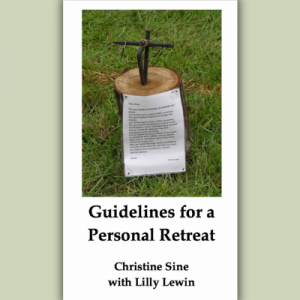 No matter the time of year, it’s important to pause and take time to reset and restore. An excellent way to do that? Take a personal retreat. Building a retreat into the rhythm of your life is a spiritual practice often lost in our helter-skelter, busyness-is-next-to-godliness world. This booklet is based on the most popular posts about spiritual retreats published on Godspacelight.com over the last few years and provides resources for taking a spiritual retreat either on your own or with a friend or spouse. Check it out in our shop!
No matter the time of year, it’s important to pause and take time to reset and restore. An excellent way to do that? Take a personal retreat. Building a retreat into the rhythm of your life is a spiritual practice often lost in our helter-skelter, busyness-is-next-to-godliness world. This booklet is based on the most popular posts about spiritual retreats published on Godspacelight.com over the last few years and provides resources for taking a spiritual retreat either on your own or with a friend or spouse. Check it out in our shop!
A contemplative service with music in the spirit of Taizé. Carrie Grace Littauer, prayer leader, with music by Kester Limner and Andy Myers.
Permission to podcast/stream the music in this service obtained from One License with license #A-710-756.
‘Tis A Gift to be Simple – Traditional words and music from the American Shaker tradition, public domain.
Atme in Uns — Copyright and all rights reserved by GIA/Les Presses de Taizé
Permission to podcast/stream the music in this service obtained from One License with license #A-710-756.
Your Word, O Lord, is a Light – Copyright and all rights reserved by GIA/Les Presses de Taizé Permission to podcast/stream the music in this service obtained from One License with license #A-710-756.
Litany of the Beatitudes – Text and music by Kester Limner, 2022, shared under the Creative Commons License, Attribution (CC-BY)
Step by Step – This song was written by the American folk musician Pete Seeger, and appears on the album “Songs of Struggle and Protest 1930-1950”, released in 1964. I believe it’s currently in the public domain, and if it isn’t, I think Pete would have wanted us to share it anyways.
Thank you for praying with us!
As an Amazon Associate, I receive a small amount for purchases made through appropriate links.
Thank you for supporting Godspace in this way.
When referencing or quoting Godspace Light, please be sure to include the Author (Christine Sine unless otherwise noted), the Title of the article or resource, the Source link where appropriate, and ©Godspacelight.com. Thank you!

